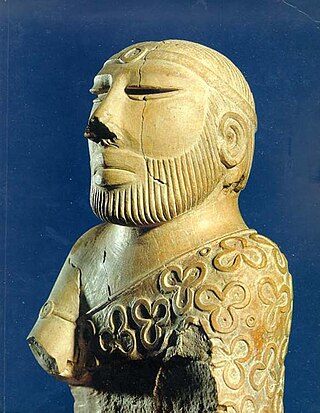
Sindh is a province of Pakistan. Located in the southeastern region of the country, Sindh is the third-largest province of Pakistan by land area and the second-largest province by population after Punjab. It is bordered by the Pakistani provinces of Balochistan to the west and north-west and Punjab to the north. It shares an International border with the Indian states of Gujarat and Rajasthan to the east; it is also bounded by the Arabian Sea to the south. Sindh's landscape consists mostly of alluvial plains flanking the Indus River, the Thar Desert in the eastern portion of the province along the international border with India, and the Kirthar Mountains in the western portion of the province.

Thatta is a city in the Pakistani province of Sindh. Thatta was the medieval capital of Sindh, and served as the seat of power for three successive dynasties. Its construction was ordered by Jam Nizamuddin II in 1495. Thatta's historic significance has yielded several monuments in and around the city. Thatta's Makli Necropolis, a UNESCO World Heritage Site, is site of one of the world's largest cemeteries and has numerous monumental tombs built between the 14th and 18th centuries designed in a syncretic funerary style characteristic of lower Sindh. The city's 17th century Shah Jahan Mosque is richly embellished with decorative tiles, and is considered to have the most elaborate display of tile work in the South Asia.

The Tarkhan dynasty, was established by a Tarkhan and ruled the Sindh Sultanate from 1554 to 1593. General Mirza Isa Beg founded the Tarkhan dynasty in Sindh after the death of Shah Husayn Arghun of the Arghun dynasty.
The Samma dynasty was a medieval Sindhi dynasty which ruled the Sindh Sultanate from 1351 before being replaced by the Arghun dynasty in 1524.

The Arghun dynasty ruled over the area adjoining Southern Afghanistan and then the Sindh Sultanate from the late 15th century to the early 16th century. Arghun rule can be divided into two branches: the Arghun branch of Dhu'l-Nun Beg Arghun that ruled until 1554, and the Tarkhan branch of Muhammad Isa Tarkhan that ruled until 1593.
Raja Dahir was the last Hindu ruler of Sindh. A Brahmin ruler, his kingdom was invaded in 711 CE by the Arab Umayyad Caliphate, led by Muhammad bin Qasim, where Dahir died while defending his kingdom. According to the Chachnama, the Umayyad campaign against Dahir was due to a pirate raid off the coast of the Sindhi coast that resulted in gifts to the Umayyad caliph from the king of Serendib being stolen.
Badin is the main city and capital of Badin District in Sindh, Pakistan. It lies east of the Indus River. It is the 105th largest city in Pakistan. Badin is often called 'Sugar State' due to its production of sugar.

Thatta District is located in the southern area, locally called Laar, of the province of Sindh, Pakistan. Its capital is Thatta. It is home to a large necropolis of Makli. In 2013, several talukas were separated to form the new Sujawal District.
Shahbandar is a historical port town in Sujawal District, Sindh, Pakistan. During its heyday in the late 1700s, Shahbandar reportedly was home to as many as 50,000 people, but it soon lost its port access and went into a steep decline.

Debal was a commercial town and an ancient port in Sindh, now a province of Pakistan.

The history of Sindh refers to the history of the modern-day Pakistani province of Sindh, as well as neighboring regions that periodically came under its sway.

Makli Necropolis is one of the largest funerary sites in the world, spread over an area of 10 kilometres near the city of Thatta, in the Pakistani province of Sindh. The site houses approximately 500,000 to 1 million tombs built over the course of a 400-year period. Makli Necropolis features several large funerary monuments belonging to royalty, various Sufi saints, and esteemed scholars. The site was inscribed as a UNESCO World Heritage Site in 1981 as an "outstanding testament" to Sindhi civilization between the 14th and 18th centuries.

Francisco Barreto was a Portuguese soldier and explorer. An officer in Morocco during his early life, Barreto sailed to Portuguese India and was eventually appointed viceroy of the colony. After his return to Lisbon, he was tasked with an expedition to southeast Africa in search of legendary gold mines. Barreto died in what is now Mozambique, having never reached the mines.

Mansura, referred to as Brahmanabad or Bahmanabad in later centuries, was the historic capital of the caliphal province of Sindh, during the eighth century under the Umayyad Caliphate and then Abbasid Caliphate from the year 750 AD to 1006 AD. The city was founded as a central garrison by the Umayyad Forces in Sindh, the city transformed into a very vibrant metropolis during the Abbasid Era surpassing the wealth of Multan in the north and Debal in the south. Mansura was the first capital established by the Muslims in the Indian subcontinent after Muhammad bin Qasim seized the Brahmanabad territory. Mansura was built on the shores of the Indus River, it was surrounded by fertile farmland, Ibn Hauqal mentioned the wealthy local merchants who wore Baghdad Costume and were of Sindhi-Arab origins, houses were made of clay, baked bricks and plaster.

Shah Inayatullah, popularly known as Sufi Shah Inayat Shaheed, Shah Shaheed or Shah Inayat of Jhok, was a 17th-century Sindhi Sufi saint and revolutionary from Jhok. He was the first socialist and agricultural reformist of Sindh.
Jam Mubarak Khan Qabulio Sammo, was a general of the Samma Dynasty of Sindh, a statesman and regent at the court of Samma ruler Jam Feroz.
Kakrala was a historical region in southern Sindh, in the coastal parts of the Indus Delta. Descriptions of its precise extent vary, but it lay in the middle part of the delta, comprising the present-day taluqas of Shahbandar and Jati in Sujawal and Thatta districts. It has been described as the region from Jati to Kharo Chan, or the region between the mouths of the Wanyani and Pitti rivers. This area later formed part of the pargana of Ghorabari.

Mirza Jani Beg Tarkhan was the last Sultan of Sindh. He succeeded his grandfather Mirza Muhammad Baqi after his death. He ruled from 1585 to 1591 as an independent monarch of Sindh but was forced to submit to Mughal authority. He later involuntarily abdicated in 1593 and a Mughal Subahdar was appointed in his place. But due to social and public unrest, the Mughal authority appointed Jani in his place in 1594. Jani continued to serve as the Mughal Subahdar till his death in 1601.

The Thatta Sarkar (1593–1629), Thatta Subah (1629–1737) or Sind State (1737–1843), also referred to as Scinde or Sindh, was a Mughal Sarkar later a Subah, then a proto-state, and lastly a princely state in the Sindh region of the Indian subcontinent until its annexation by the East India Company in 1843. The name Sind, now obsolete, was once the anglicized name of the state, which was also adopted by the British to refer to its division.
In 1574, Akbar captured the island fortress of Bhakkar as part of his efforts to extend his control over the southern region of Sind near the Indus River's mouth. This strategic move aimed to solidify his dominance in northwestern India and establish a base for launching an offensive against Kandahar, which was then under the rule of Shah Abbas of Persia.













